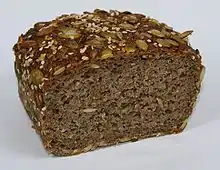Sprouted bread
Sprouted bread is a type of bread made from whole grains that have been allowed to sprout, that is, to germinate, before being milled into flour. There are a few different types of sprouted grain bread. Some are made with additional added flour, some are made with added gluten, and some, such as Essene bread and Ezekiel bread (after an ancient bread formula in Ezekiel 4:9, however that recipe was baked with excrement Ezekiel 4:15), are made with very few additional ingredients.
.jpg.webp) Vegan flourless sprouted wheat bread | |
| Type | Bread |
|---|---|
| Main ingredients | Whole grains (sprouted) |
Overview
.jpg.webp)
Sprouted breads contain the whole, sprouted grain (the kernel, or berry) of various seeds. They are different from white bread inasmuch as white breads are made from ground wheat endosperm (after removal of the bran and germ). Whole grain breads include the bran, germ, and endosperm, therefore providing more naturally occurring fiber, vitamins and proteins. Sprouted (or germinated) grain breads have roughly the same amount of vitamins per gram. Sprouted grain bread has 47% less gluten than regular bread.[1]
A comparison of nutritional analyses shows that sprouted grains contain about 75% of the carbohydrates, slightly higher protein and about 40% of the fat when compared to whole grains.[2][3]
In addition to wheat, sprouted breads may contain grains and legumes such as millet, barley, oat, lentil and soy. Bread that is made from an array of grains and legumes can provide a complete set of amino acids, the building blocks of proteins. Sprouted breads may contain slightly more trace minerals and nutrients than non-sprouted breads. Other than that, they supply much the same advantages as whole grain breads over refined grain breads, such as lowered risk of coronary heart disease.[4]
Essene bread

Essene bread is a simple form of sprouted grain bread made from sprouted wheat and prepared at a low temperature. Proponents of raw foods often eat it uncooked or slightly heated.[5][6] The Essenes, a Jewish religious group that flourished from the 2nd century BC to the 1st century AD, are credited with the technique and basic recipes for Essene bread,[7] although no scholarly evidence exists for this claim. Sprouting and low-temperature preparation ensure the maximum possible vitamin content for this foodstuff.[7] Sprouting also breaks down the lectins and other substances that some individuals may be sensitive or allergic to.[7]
See also
- Health food
- List of breads
- Malt
- Malt loaf
- Multigrain bread
- Wheatberry, a whole-wheat kernel before sprouting
References
- Groves, Melissa (20 June 2018). "7 Great Reasons to Add Sprouted Grain Bread to Your Diet". Healthline. Retrieved 18 February 2019.
- "Nutritive Value of Foods, Home and Garden Bulletin No. 72 (HG-72)". United States Department of Agriculture. 2002. Retrieved 2012-01-12.
- "Wheat sprouts". International Specialty Supply. Retrieved 2012-01-12.
- "Sprouted-grain breads: the facts". Los Angeles Times. 2009-10-12. Retrieved 2012-01-12.
- Archived June 22, 2008, at the Wayback Machine
- "About Sprouted Flour & Related Info | Summers Sprouted Flour Co". Creatingheaven.net. Retrieved 2013-05-26.
- "The Benefits Of Essene Bread". Livestrong.Com. Retrieved 2013-05-26.
